Although there was good potential for anything after the spectacular eclipse to be anticlimactic, this did not turn out to be the case. There is so much beauty and interest in Oregon and northern California that the eclipse was quickly forgotten.
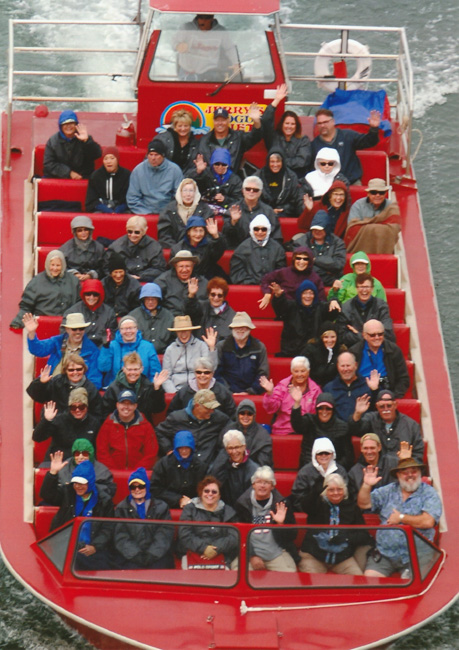
We had a leisurely breakfast before packing and heading to our next adventure. We loaded into a large jetboat for a trip up the Rogue River and back. The concessionaire, Jerry's Rogue Jets, offers a variety of excursions. We were on the 64-mile route, which included lunch. Jetboats were originally developed for New Zealand and we saw many there.
We bought the group picture taken by the company that showed our boat. Jim and I have strategically placed ourselves as close to the middle as we could get in a vain attempt to stay dry if (when!) the driver decided to make some fancy spins.
The start of the ride was quite cold because we were on the coast, which is always pretty chilly from the proximity of the Pacific. In addition to our own coats, the company also made available loaner coats for those who needed them and woolen blankets to keep our legs warm and more-or-less dry.
By the time we reached our lunch spot, which was much farther inland, it was quite warm and we shed our layers. After lunch they went back on again as we neared the coast.

We saw a number of different kinds of birds including this great blue heron, which turns out to be Portland's official bird! Great blue heron week is celebrated end of May/beginning of June.
Other birds that I didn't get good pictures of include ospreys, great egrets and green herons. Our guide also spotted a harbor seal in the water, but I never saw it.
Our guide showed us one tree with a sole osprey. He said that ospreys return to the same nest year after year, but if there is a year when they fail to raise chicks successfully, they will destroy the nest. He told us that this had happened at this particular tree and that he felt the sole bird was mourning the loss of the chicks and the nest. I have not been able to find anything to verify this in searching bird sites and I am skeptical. But it makes a good story!
 In addition to the many birds we encountered on the trip, we also saw
this young black-tailed deer buck. He didn't seem much intimidated by
our presence, but eventually moved off into the woods.
In addition to the many birds we encountered on the trip, we also saw
this young black-tailed deer buck. He didn't seem much intimidated by
our presence, but eventually moved off into the woods.
His antlers were still in velvet.

We saw more than one eagle, but this is the best picture that I got.

This young black bear was much shyer than the deer. S/he appeared very healthy and had a particularly beautiful coat that rippled and glistened with movement.
Black bear are not rare sightings here in Rockbridge County, VA, where Jim saw one crossing our suburban street not long ago! It is always better to see one in the wild than in the back yard!
Our guide said that we had seen pretty much all the wildlife there was to see in the area except cougar. In all his years of guiding on the river, he had only ever seen one -- and was surprised to see it!
I intended to get a picture of the cat that visited our lunch spot and claim it was a black panther, but I missed the opportunity!

It seemed like just about every boat had at least one dog. Our driver's dog was named "Roo" and she just LOVED for folks to toss things for her to catch. I'm happy to say that she stayed away from the guests to shake the water out of her coat. Good dog!

We enjoyed lunch at Singing Springs on the bluffs above the river before returning to "port." On the way back our guide treated us to a couple of splashy 360° turns. Although Jim and I had carefully selected seats in the center of the boat, we didn't escape the spray.
The haze is due to nearby forest fires. The roads between Gold Beach and Eureka where we were to spend the night had been closed briefly due to the fires, but we had no trouble. They were closed again later and some folks had to be evacuated.
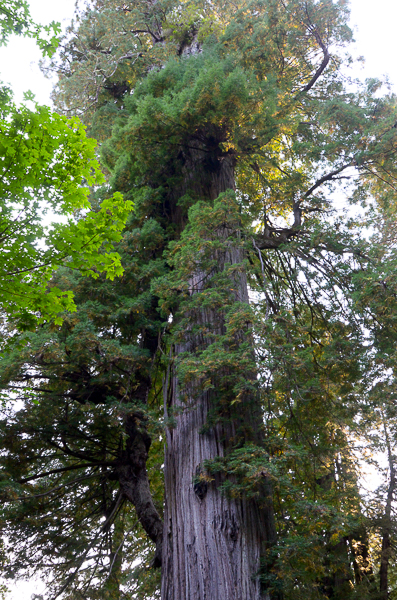
On our way to Eureka we stopped at Prairie Creek Redwoods State Park to visit the Big Tree (shown here). Carol led us on a short hike through these magnificent trees. Many on the trip agreed that the redwoods had been the most impressive part of the expedition (after the eclipse, of course).
It is impossible to get a decent picture of a redwood -- they are too big. If there were one out in the open, perhaps it might be possible, but by their nature they grow in groves. Their roots are shallow and it is only through interlacing roots of many trees that they are able to grow so tall and withstand winds and weather.
Although this tree is called "Big Tree" it is only 286 feet tall, which makes it far from the tallest. It is estimated to be 1500 years old.
Another feature of redwoods is that their canopy becomes a kind of miniature forest with multiple leaders that look like independent trees. Soil builds up in the canopy and other kinds of trees and shrubs might take root and grow. For a fascinating and readable discussion of redwoods, read the book Wild Trees by Richard Preston. Click for an interview with Preston done for NPR that describes the trees and research that has been done on them.
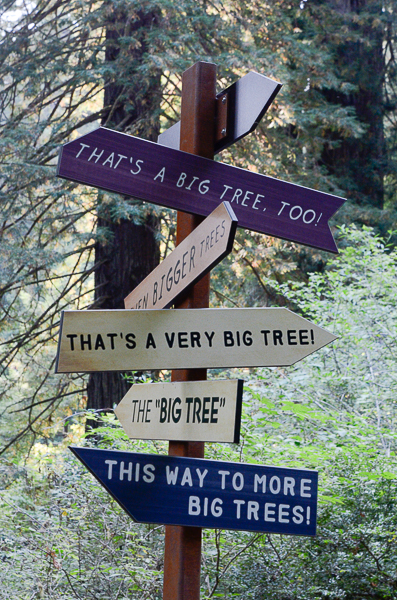
I loved this whimsical signpost near the Big Tree.
Many of the individual redwoods have names. We were introduced to some of them.
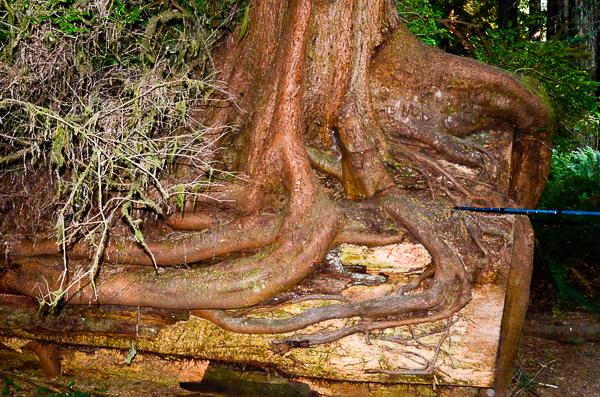
Redwoods are very resistant to insect damage and rot, which is why the wood is so valued. Therefore when they do fall and die (and they fall BEFORE they die), they take a very long time to decay. Fallen trees become nurse logs and nurture plants that take root in or on them.
This redwood log has provided a base for a maple tree, which has grown to a large size simply drawing on the log.
(The blue line is Carol's hiking stick pointing out the root growth.)
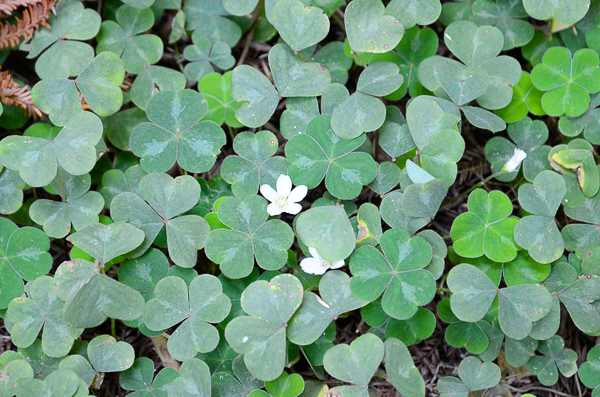
Redwood sorrel was everywhere among the redwood forests. I saw only a few blossoms, however. The leaves are very sensitive to light and will fold up if it gets too bright.
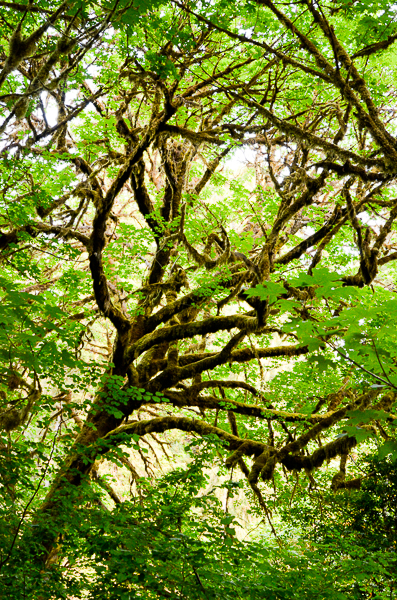
The forests also contained some other trees. This is a bigleaf maple, which is often found in the mixed forests. It can itself reach 100' in height and may live 300 years. This is impressive on its own, but in comparison to the redwoods, not so much.
The mosses and lichens on this tree's trunk and branches are not parasitic. They are commonly found in moist environments such as these, and do not harm the tree.
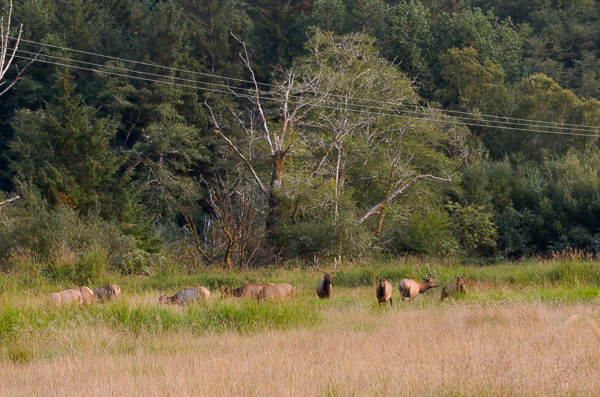
As we proceeded to Eureka we saw a large gathering of Roosevelt Elk near the highway. A number of other cars were stopped along a side road, so we pulled off and stopped too. We noticed that the groupings often included more than one bull elk. Lynn said that they probably had grown up together and had already worked out their pecking order. When the rut starts, which will be shortly, the situation will become more volatile.
Jim and I used to see elk in the same general area on our trips to Oregon for skiing and wine tasting. We were dismayed that sometimes people encouraged their friends or children to approach the animals for better pictures. Some folks don't understand that wild animals are not Disney automata. They are unpredictable and can be very dangerous!
Click your "back" button to return to the previous page or click for our picture album.